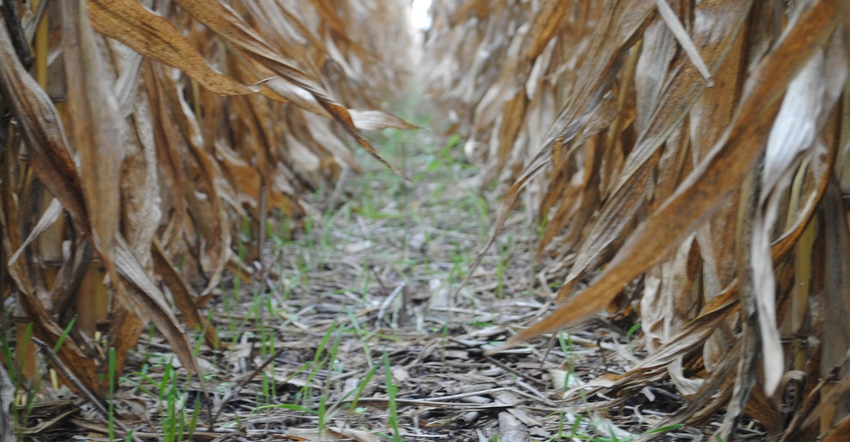
There are basic advantages for cover croppers seeding under irrigation, but there are challenges as well.
“Irrigated land gives us a little more flexibility in a corn-soybean crop rotation, to apply the cover crop aerially with an airplane or high-boy cover crop interseeder,” says Austin Baldwin, a Natural Resources Conservation Service conservationist in Knox County, Neb. “It’s important to either have good moisture currently on the soil surface or to get moisture within a few days of seeding” in the fall, he says.
“It can be done on dryland acres as well, but I don’t recommend it if the topsoil doesn’t have adequate moisture currently, and it doesn’t look like we will catch a significant rain within the next week or so," he adds.
Baldwin says that irrigating right after the cover crop is aerially applied allows some of the seed that gets caught in the crop canopy to vibrate off the leaves and get better seed-to-soil contact.
“I’ve seen more consistent success with aerial-applied cover crops on irrigated land,” Baldwin says. “And this allows us to get four or more weeks of growth before someone could get a cover crop drilled following harvest.” That’s a lot of cover and biomass produced in the fall.
For those drilling cover crops, irrigation may be more of a disadvantage. “For those who would rather drill after corn or soybean harvest, longer-season corn or soybean varieties are planted on irrigated acres,” Baldwin says. “If dryland corn or soybeans mature quicker and are harvested earlier, it can allow for more cover crop growth in that fall time frame than if it was drilled following later-maturing irrigated corn or soybeans.”
Baldwin says that most cover crop growth occurs in northeast Nebraska in the spring, when there is ample moisture. “However, it can be a huge advantage if you are planting a cover crop as a full season cover or planting it following a small grain harvest,” he explains. “July and August can be hot and dry. While the dryland cover crop could start to suffer in the middle of the summer, irrigation gives us the potential to have extra biomass production over dryland cover crops.”
The downside is that irrigators often are less likely to plant small grains on irrigated land in many portions of the Great Plains. “Corn and soybean rotations dominate our irrigated land,” Baldwin says. “This doesn’t allow for a very long cover crop growth time frame, and it decreases our potential for getting the full benefits out of our cover crops.”
Covers planted after small grain harvest in late summer or full season cover crops open the growth time frame and give producers more flexibility in the species that can be planted, Baldwin says. “However, when small grains are planted on irrigated land with a cover crop following harvest, you have a lot more potential for increased biomass,” he notes.
More biomass opens opportunities for livestock grazing. Flying cover crops earlier in the growing season provides more potential for fall growth. But it is the spring growth that really pays off if grazing is the main goal, Baldwin says. Normally, many regions receive enough natural rainfall in the spring to boost that growth, but irrigation is one way to mitigate drier years.
“Cover crops seeded into small grains is where we really get great grazing opportunities,” Baldwin says. “It can be a great place to bring cattle after they come off grass and before cornstalks are ready. It can be a great place to go with 500- to 600-pound calves after weaning them.”
Baldwin says on their own farm they planted a cover crop mixture in mid-July 2019. The covers were tested for nutrition and were rated more than adequate for weaned calves, even without supplemental forages.
“We were just running cows on it, but the potential to diversify your operation without needing a feed wagon is interesting,” he says. “Irrigation can help get the pounds of cover crop growth that you need to produce a lot of biomass to graze.”
On the irrigation side, Baldwin reminds producers that farms with extremely health soils from years of no-till, cover crops and good soil management may not see the benefits of irrigation on cover crops as much as a farm with poorer soils that is transitioning to cover crops and other soil health practices.
Learn more by contacting Baldwin at 402-373-4914, ext. 3.
About the Author(s)
You May Also Like






